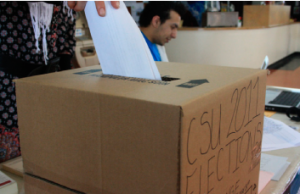
You’re probably one of the people that was put off by the sight of Action candidates fielding students and bringing them to polling booths, all the while wearing their familiar blue t-shirts. Naturally, campaigning is verboten during the polling periods for CSU elections and referendums. After two weeks of poster plastering, classroom visits and other bombardment, students get a pause to go back to quieter times and and make their voting decision without being assaulted every time they get to the elevators.
This year, both slates came clad in t-shirt uniforms. Fortunately for Action, in a sense, they chose the colour blue to identify themselves (and potentially separate themselves from their past purple-hued slates). Your Concordia went for a more colourful option, not sticking with one colour. Instead, they branded themselves with a strong font and a palette of Easter pastels.
But this rainbow option means that your candidates are less identifiable as a group, from a distance.
So, while both teams engaged in persuading voters to step up to vote (for whomever they want, we presume), directing them to polling booths and handing them copies of campus newspapers, Action stood out from day one with their electric blue accoutrements. They turned their shirts inside out, so that their logos were only lightly visible backwards. Using the shirts as a running tally of voter apathy, they marked them with Sharpies each time someone refused to vote.
A creative ploy to demonstrate just how exhausted or how turned off Concordia students are, but still an intimidating act to pull in front of a student leisurely or hurriedly going to class.
This is one of the few grey areas that cropped up during the campaign this week – is taking your branded t-shirt and turning inside out a safe way to go about persuading voters to vote while subtly telegraphing your party allegiances? Chief electoral officer Oliver Cohen decided that this constituted a violation, and midway through the polling dates, he issued a short new slew of directives to candidates through their presidential hopefuls. Included was the new rule banning the wearing of campaign shirts, inside out or otherwise. The distance candidates were to keep from polling stations was 20 metres, up from a measly 10 metres. And, no saying or writing on blackboards anything but “go vote.”
Disappointingly, this did not stop Action from chucking their marked-up t-shirts and starting fresh. Instead, they picked up new, blank blue t-shirts and blue sweaters and headed back out to the polls the next day. You have to admire political candidates who profess to care so much about voter apathy that they’ll take time to push voters to the polls themselves. But in this case, Action candidates were motivated purely by self-interest. Concordia students aren’t stupid; clearly, someone wearing a blue t-shirt is running for the blue team. Greeting students with blue t-shirts is clearly campaigning; you’ve identified yourself, extended a hand and made a new contact.
Cohen should have emphasized that campaign colours were not to be worn – no t-shirts, no bandannas, no matching eye shadow. Of course, with dozens of candidates over two slates, and one without a clear colour code, the challenge of enforcing this rule would be almost insurmountable. Nevermind the fact that Cohen’s polling employees were largely unawares of the new directives issued by the last day of polling. Issuing new rules is one thing, assuring that they can be enforced competently is another, and this was not done effectively.
The other solution is to forgo the no-campaigning rule whatsoever. If policing people who are old enough to know better is too difficult, why don’t we just do it like they do in the big leagues, and allow campaigning. To be sure, candidates are exhausted by the time polling comes around, and some might have limited resources that keep them from continued campaigning.
But in order to keep things fair, you might as well open the flood gates, and allow campaigning up until the polls close for good.
While the voter turnout was impressive compared to previous years, we can’t be totally sure of what ultimately brought out students to the polls in stronger numbers this year. Did Action’s proactive blue measures hurt them in the end because students saw through their tactics? Or did Your Concordia just run a more responsive, intellectual campaign?
We’d like to think that it was students are realizing that we’re in trouble, and we need strong leadership. Effectively, Concordia students are in a certain measure of crisis – our Board of Governors is laden with members who are passed their term, the student centre will be a building students dislike, their is disagreement over tuition, and so on. Day-to-day, you’d find little evidence that the union is under tremendous pressure, but you can be assured that how the student union handles itself in the next year will have long-term impacts on how students carry on their academic careers.





Comments are closed.